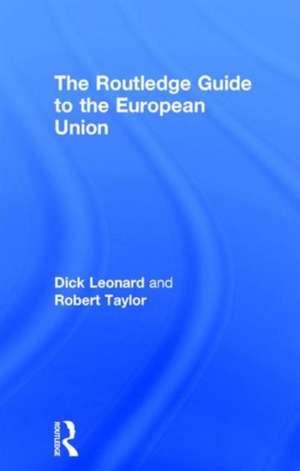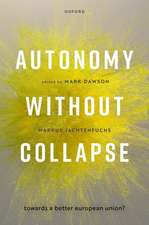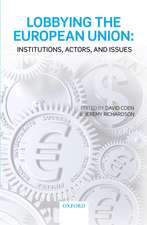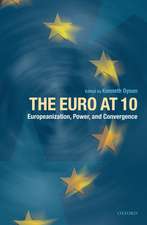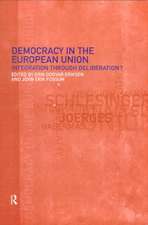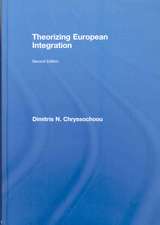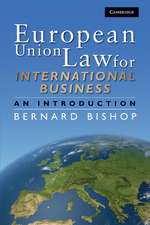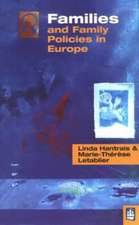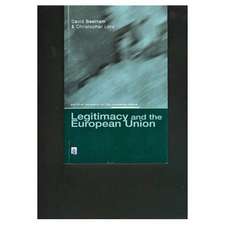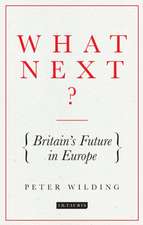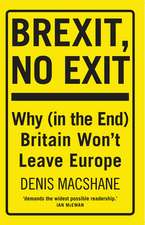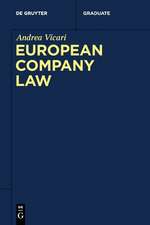The Routledge Guide to the European Union
Autor Dick Leonard, Robert Tayloren Limba Engleză Hardback – 31 mai 2016
- How it works: the institutions, the mechanisms
- Every area of EU competence from agriculture to workers' rights
- The effects of the single market and the single currency and the successes and stresses of the eurozone
- The impact of the enlargement of the EU and the prospects for further enlargement and for closer political integration
- The EU under strain - the 2008 recession and after
- 'Britain in or out'
- Fully updated and revised material with new data, statistics, examples and non-partisan coverage
| Toate formatele și edițiile | Preț | Express |
|---|---|---|
| Paperback (1) | 323.28 lei 6-8 săpt. | |
| Taylor & Francis – 23 mai 2016 | 323.28 lei 6-8 săpt. | |
| Hardback (1) | 1003.43 lei 6-8 săpt. | |
| Taylor & Francis – 31 mai 2016 | 1003.43 lei 6-8 săpt. |
Preț: 1003.43 lei
Preț vechi: 1223.70 lei
-18% Nou
Puncte Express: 1505
Preț estimativ în valută:
192.07€ • 208.70$ • 161.44£
192.07€ • 208.70$ • 161.44£
Carte tipărită la comandă
Livrare economică 21 aprilie-05 mai
Preluare comenzi: 021 569.72.76
Specificații
ISBN-13: 9781138670389
ISBN-10: 1138670383
Pagini: 366
Ilustrații: 8
Dimensiuni: 138 x 216 mm
Greutate: 0.54 kg
Ediția:1
Editura: Taylor & Francis
Colecția Routledge
Locul publicării:Oxford, United Kingdom
ISBN-10: 1138670383
Pagini: 366
Ilustrații: 8
Dimensiuni: 138 x 216 mm
Greutate: 0.54 kg
Ediția:1
Editura: Taylor & Francis
Colecția Routledge
Locul publicării:Oxford, United Kingdom
Public țintă
Professional Practice & Development and UndergraduateCuprins
Introduction
Part I: The Background
1. The Origins
2. Evolution 1958-2010
3. The EU under strain 2008-
4. The Treaties
Part II: The Institutions
5. The Commission
6. The Council of Ministers
7. The European Council
8. The European Parliament
9. The Economic and Social Committee and The Committee of the Regions
10. The European Court of Justice
11. The Court of Auditors
12. The European Investment Bank
13. Other EU bodies
14. The Bureaucracy: facts, figures and costs
Part III: The Competences
15. Financing the Union
16. Trade
17. The Single Market
18. Competition Policy
19. Economic and Monetary Policy
20. Taxation
21. Agriculture
22. Fisheries
23. Research and Innovation
24. Regional Policy
25. Workers’ Rights
26. Energy
27. Transport
28. The Environment
29. Climate Change
30. Justice and Home Affairs
31. Consumers
32. Education
33. Women's Rights
34. Culture and The Media
35. Citizens' Rights and Symbolism
36. Development Assistance
37. Foreign, Security and Defence Policy
Part IV: Special problems
38. Enlargement
39. The UK: In or Out?
40. The Future
Appendices
1. Basic statistics of EU member states
2. Presidents of the High Authority, Commission & European Council
3. The European Commission 2014-19
4. The Directorates-General and Services of the Commission
5. Addresses of main institutions & specialised agencies
6. Political party groups in the European Parliament
7. Overseas links with the EU
8. The treaties of Maastricht, Amsterdam, Nice and Lisbon
9. Chronology of main events concerning the European Union
Part I: The Background
1. The Origins
2. Evolution 1958-2010
3. The EU under strain 2008-
4. The Treaties
Part II: The Institutions
5. The Commission
6. The Council of Ministers
7. The European Council
8. The European Parliament
9. The Economic and Social Committee and The Committee of the Regions
10. The European Court of Justice
11. The Court of Auditors
12. The European Investment Bank
13. Other EU bodies
14. The Bureaucracy: facts, figures and costs
Part III: The Competences
15. Financing the Union
16. Trade
17. The Single Market
18. Competition Policy
19. Economic and Monetary Policy
20. Taxation
21. Agriculture
22. Fisheries
23. Research and Innovation
24. Regional Policy
25. Workers’ Rights
26. Energy
27. Transport
28. The Environment
29. Climate Change
30. Justice and Home Affairs
31. Consumers
32. Education
33. Women's Rights
34. Culture and The Media
35. Citizens' Rights and Symbolism
36. Development Assistance
37. Foreign, Security and Defence Policy
Part IV: Special problems
38. Enlargement
39. The UK: In or Out?
40. The Future
Appendices
1. Basic statistics of EU member states
2. Presidents of the High Authority, Commission & European Council
3. The European Commission 2014-19
4. The Directorates-General and Services of the Commission
5. Addresses of main institutions & specialised agencies
6. Political party groups in the European Parliament
7. Overseas links with the EU
8. The treaties of Maastricht, Amsterdam, Nice and Lisbon
9. Chronology of main events concerning the European Union
Notă biografică
Dick Leonard is a journalist, author and former Labour MP. He was Assistant Editor of The Economist for 12 years, and has also worked for The Observer, the BBC, the Fabian Society, the Centre for European Policy Studies and the Publishers Association.
Robert Taylor runs European Research Associates, a Brussels consultancy specialising in European public policy. For more than 30 years, he worked as a journalist and foreign correspondent, covering the European Union, reporting on its performance, policies and personalities.
Robert Taylor runs European Research Associates, a Brussels consultancy specialising in European public policy. For more than 30 years, he worked as a journalist and foreign correspondent, covering the European Union, reporting on its performance, policies and personalities.
Recenzii
"Ever since it was first published, Leonard’s Guide to the European Union has played an invaluable role in unravelling these mysteries and complexities [of the European Union]. It is especially valuable, and rare, for doing so in a sober, meticulous and non-partisan way… No one could be better qualified to produce an updated, authoritative and highly readable guide than Leonard and Taylor." - Bill Emmott, Editor-in-Chief of The Economist from 1993-2006.
"The Economist Guide to the EU is the best book I know that explains clearly the complexities of the EU to the intelligent layman… Curios (sic) voters will find this book a useful source of objective information about the EU, and I have no doubt that it will be respected as such by both defenders and critics of the EU. In the longer run many students, business people or politicians that need to deal with the Brussels institutions will feel that they should own this book." - Charles Grant, Director of the influential think-tank, the Centre for European Reform (CER).
"Dick Leonard's Guide to the European Union has long had a deserved reputation for clarity and reliability. His new, updated edition comes at an important moment in the history of European integration and will be a valuable aid to the public debate in Britain and throughout the European Union." – John Palmer, former European Editor of The Guardian and former Political Director of the European Policy Centre.
"An indispensable guide still highly relevant to the debate, and, arguably more important than ever. Whatever happens from now on, Brexiteers and Remainers should appreciate this wonderful guidebook, written by two of the greatest experts on the European Union.’ - William Keegan, senior economics commentator, The Observer
"In times like these, politicians, journalists and the public are desperate to find a concise but authoritative exposition of the ways and workings of the EU. In this book, they find just that: from the history of the EU, through its institutions to an examination of the competences. An invaluable guide in uncertain times!" - Kier Starmer, QC MP, and Shadow Brexit Secretary
"The Economist Guide to the EU is the best book I know that explains clearly the complexities of the EU to the intelligent layman… Curios (sic) voters will find this book a useful source of objective information about the EU, and I have no doubt that it will be respected as such by both defenders and critics of the EU. In the longer run many students, business people or politicians that need to deal with the Brussels institutions will feel that they should own this book." - Charles Grant, Director of the influential think-tank, the Centre for European Reform (CER).
"Dick Leonard's Guide to the European Union has long had a deserved reputation for clarity and reliability. His new, updated edition comes at an important moment in the history of European integration and will be a valuable aid to the public debate in Britain and throughout the European Union." – John Palmer, former European Editor of The Guardian and former Political Director of the European Policy Centre.
"An indispensable guide still highly relevant to the debate, and, arguably more important than ever. Whatever happens from now on, Brexiteers and Remainers should appreciate this wonderful guidebook, written by two of the greatest experts on the European Union.’ - William Keegan, senior economics commentator, The Observer
"In times like these, politicians, journalists and the public are desperate to find a concise but authoritative exposition of the ways and workings of the EU. In this book, they find just that: from the history of the EU, through its institutions to an examination of the competences. An invaluable guide in uncertain times!" - Kier Starmer, QC MP, and Shadow Brexit Secretary
Descriere
Written by experts, this long-established and definitive guide to the workings of the European Union provides comprehensive, straightforward and readable coverage of this sometimes misunderstood and complex institution. The Routledge Guide to the European Union is well-established as the clearest and most comprehensive guide to how the EU operates. This new edition brings you up to date at a crucial stage in its history at a time when, arguably, it has never been under greater threat, but conversely is perhaps more important than ever.
